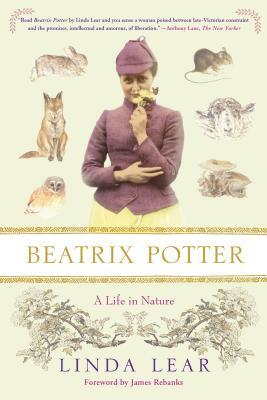Beatrix Potter: A Life in Nature by Linda Lear
Beatrix Potter: A Life in Nature reveals a lively, independent, and passionate woman, whose art was timeless, and whose generosity left an indelible imprint on the countryside. This anniversary edition is complete with a brand-new foreword by James Rebanks, the Lake District shepherd and social media sensation who chronicles his world on Twitter and in his wonderful book, "A Shepherd's Life".
Review: Born in 1866, Beatrix Potter is best known for her beloved collection of children's books featuring. She was also a landowner with a passion for preservation, a successful farmer, and sheep breeder. She was also known for her remarkable detailed illustrations and astute observations on fungi. Restricted by her conventional Victorian upbringing and her demanding mother, Beatrix was a spinster who carved out time to pursue her interests and make a little money to claim some independence from her family. She later fell in love and became engaged to her editor Norman Warne. Tragically, he died just a month after her engagement, but she embraced life as the owner of Hill Top Farm in the English Lake District. She later fell in love with William Heelis and married at the age of 47. While they never had children, it left much room in her life for her other pursuits. Until her death she was passionately engaged in her community and preserving much of her land to be given to the National Trust after her death.
It was fascinating to read about the varied interests of this remarkable lady. Lear herself acknowledges that "Beatrix Potter could have become expert in any number of fields of natural science: archaeology, botany, ornithology, mycology, geology, or entomology; each held a certain fascination for her" (98). In fact, she was still pursuing her individual research and documentation of fungi at the same time that she first conceived her beloved character Peter Rabbit: "In the space of two days she had found and painted a rare and important mycological specimen and created two fictional characters that one day would be world-famous" (87). While she never had children of her own, the endurance of her best-selling books demonstrate how well she understood and could speak to children. Indeed, she kept up lively correspondence with many of her friends' children, which is how Peter Rabbit first came to be - in a letter to entertain a sick child of a friend. Ironically, the fact that she didn't have children of her other left her free to author and illustrate works that would entertain generations of children.
I loved so much about Beatrix Potter's story. Before reading, I didn't know how deliberate she was about making her illustrations true to life in both anatomy and coloring. And I certainly had no clue about what a debt is owed to her for her work in preserving the Lake District for future generations. After her death, her and her husband's bequest to the National Trust "added over 4,300 acres to the National Trust's holdings in the Lake District and included forty separate conveyances, and sixty individual properties. There were fifteen farms, scores of cottages, several houses and more than 500 acres of woods" (444). Until the end of her life, even when physically frail and weakened from a botched surgery, she was hardworking and passionate about the projects she had undertaken. This was especially remarkable given the life of leisure her parents enjoyed. Her mother comes across as self-absorbed and miserly, especially compared to her hard working and generous hearted daughter.
I do wish more had been shared about Beatrix's husband. Although they married later in life, they were happily married for over thirty years and seem to have had a successful working partnership on their joint projects to boot. But I never got much of a sense of his personality or voice through this biography at all. Perhaps he was the quieter of the two so not is known about his interests or opinions, but I wonder what else could have been shared. I also thought it was a bit odd that more wasn't shared about why Beatrix failed to marry earlier in life.
I think it's clear from the text that Linda Lear deeply admires her subject matter and at times seems reluctant to criticize her and is eager to take her side over others. Beatrix's mother does come across as the villain of this tale, but it seems a bit unfair when it's all one sided from Beatrix's point of view. But on the whole, it's little wonder that Lear admires Beatrix Potter. What a hard-working woman, filled with zeal for nature, children, and animals and a passion for accuracy and a job well done. I am grateful that Beatrix was such an avid correspondent with her many fans far and wide, because her letters and other correspondence have left a rich trove of insight into her remarkable life.
Stars: 4



Comments
Post a Comment